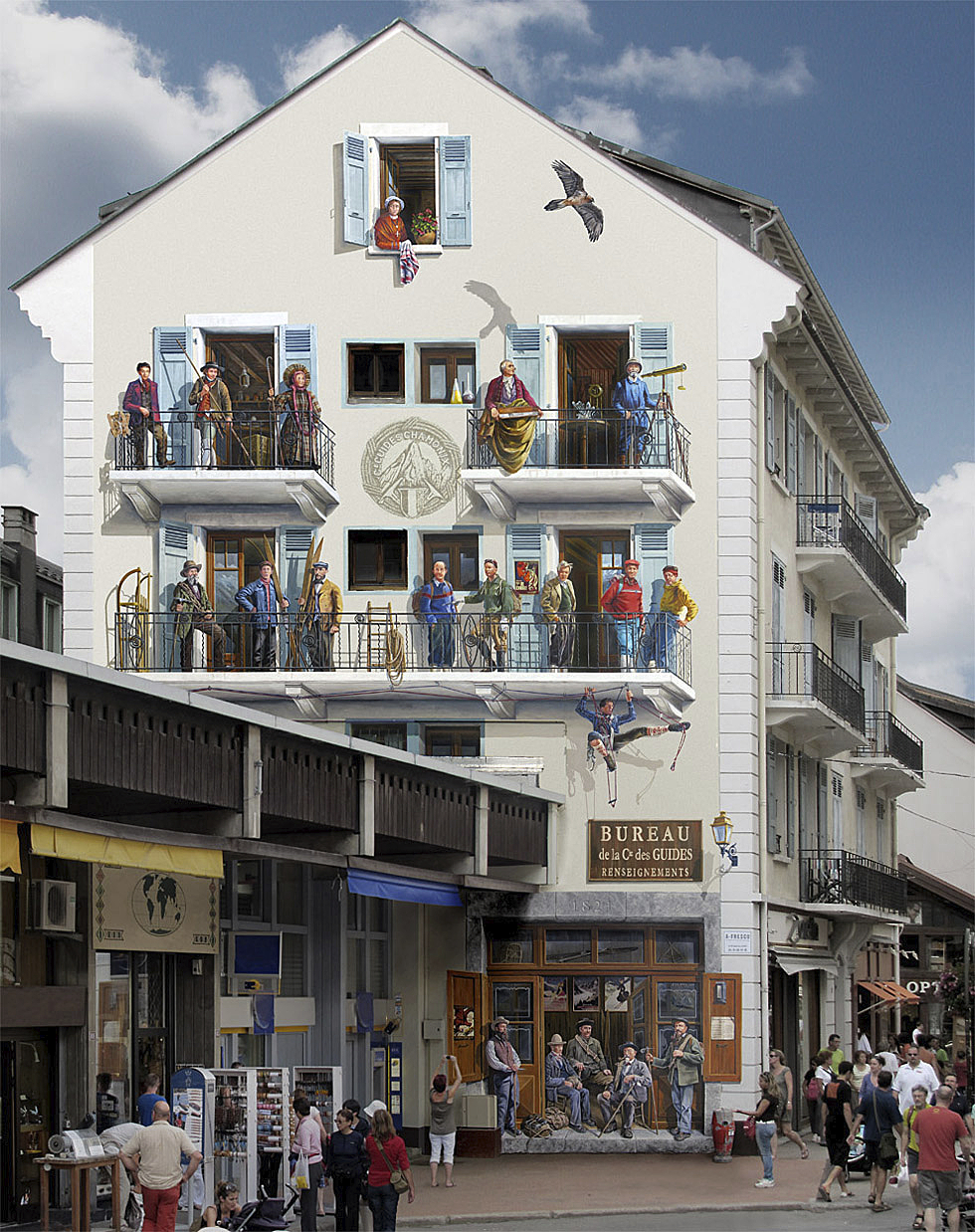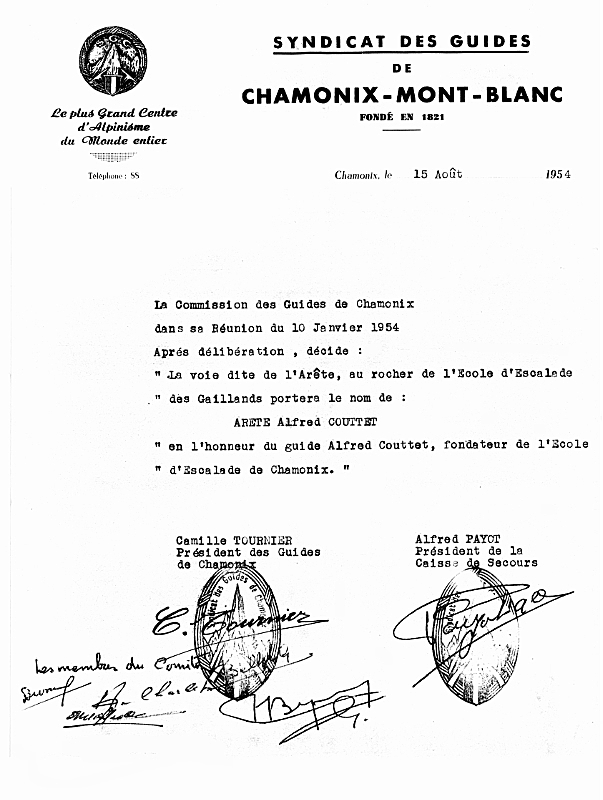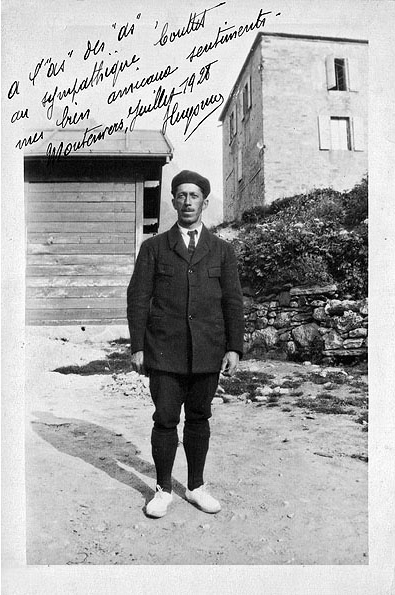Born on 8th May 1889 in Les Rebats, Chamonix.
1919! A young man returns from war.
He has just turned 30!
His face and body bore the scars of long years of suffering. He returned covered in medals and commendations, ill and weakened.
Even before the war, it was known as "COUTTET CHAMPION"!
He was a guide at the time and, as a skier, he had won some major competitions. After taking part in his first international race in 1907, he was French Champion three times: in 1909, 1913 and 1914. He raced in Norway and, unheard of at the time, finished in the top ten in the 18km race!
Yes, France does have a champion!
Even then, Alfred Couttet was at the forefront of the sport: he and his brother Jules had invented a metal ski binding that was the simplest ever designed for Nordic skiing. Robust and lightweight, it was used by all Army skiers. Alfred Couttet had plenty of time to try it out during the long patrols he carried out in the Vosges during the 14/18 storm.
With the war over, he was thirty years old and had to make a living. There was no question of him returning to guiding. He had to rebuild his health, which was in a state of disrepair, because the man who was known as the fastest of all guides, the man who, in the company of Joseph Bouchard, had completed the ascent of Mont-Blanc and back from Chamonix in 12 hours - a record that would wait almost 60 years before being beaten - he could no longer climb!
He chose to become a photographer, on the Glacier des Bossons! For three years, he overcame his weaknesses, resumed his training, and regained his lost strength. His job gave him some free time, which he used to perfect his rock climbing technique, training on all the "grattons" in the valley.
He understands that good technique is the key to success in the mountains, and that this technique can be learnt in the same way as a trade. His vocation is to teach, and he often coaches young people.
With him, we will climb the Pierre des Tines, the Pierre des Montquarts, the Aiguillettes and other steeples and bell towers.
While the mountains were temporarily off-limits to him, skiing was not. Here again, he breaks new ground.
An active member of the Alpine Sports Club, of which he was one of the founders along with his elders, the brothers Jules and Joseph Couttet, and Doctor Payot, he set up a free ski school for schoolchildren.
Every Thursday, the pupils who have been given skis by the Club are taken to the slopes of the Valley. He teaches them telemark, christiania, snowplough and, above all, the broad, supple movements of the cross-country runner, as well as springboard jumping. Marcel Bozon, Camille Couttet and myself help him in his task.
Anyone approaching fifty today will remember those days! James Couttet, Régis Charlet and so many others have become champions in their own right!
But the time came when he felt ready. Various training climbs have proved his class. Soon, the "firsts" would confirm it. First of all, he set his sights on all the bell towers, all the towers, all the capuchins that challenge climbers. He climbed the Doigt de l'Etala, the Trois Capucins du Requin... small firsts perhaps, but for the time, a great technical advance. But in the meantime, he became familiar with the major races. From the outset, he took his place among the leading guides. His courtesy, his teaching spirit and his sense of the route quickly won him a large clientele. And above all a clientele of great international mountaineers. With them, he accomplished great feats: in 1927, on 6 August, with Vital Garny as porter, he made the first ascent of the Aiguille de Roc with Miss O'Brien, an ascent that has become one of the great classics.
He enjoyed the greatest ascents of the time: the Mer de Glace, Grépon, Charmes, Blaitière and Plan faces. On 31 August 1931, he had another young American, Miss Fitzgerald, complete a traverse of the Grandes Jorasses, from the Col des Jorasses to the Col des Hirondelles.
For this first ascent on mixed terrain, he was accompanied by Anatole Bozon. Joseph Simond had already made the first ascents of the Aiguille de la République and the Aiguille des Deux Aigles, using a rope for a crossbow. Alfred Couttet made the second ascent of these two monoliths by throwing a rope with his bare hands!
The de Lepiney brothers had forced their way through the famous fissure on the N.W. face of the Peigne, but to complete the ascent they had to call on outside help. On 2 August 1930, Alfred Couttet tackled the last overhang and succeeded by free climbing!
However, it is surprising that his list of firsts is not longer; he is undoubtedly recognised as one of the greatest guides of this period; he is cited as the best rochassier while Armand Charlet is considered to be the best glaciairist, gratuitous assessments, all nuanced and which cannot oppose men of such great stature and mountaineers as complete as these two men.
This brings to light a little-known aspect of Alfred Couttet Guide's career. More than a producer of firsts, he was above all a researcher and mountaineering technician. Attracted by the Dolomites, he undertook several campaigns there. He brought back the use of pitons, experience of vertical walls and also the first shoes with felt soles, at a time when in the Western Alps people were climbing with nails. With his clients, he travelled all over mountainous Europe: Poland with the Tatras, the Beskids in Slovakia, the Carpathians in Romania. Not to mention the Alps, which he knows inside out. Summer and Winter, because he was also one of the promoters of long ski tours. He climbed the Spanish Sierras and, still attracted by pure climbing, discovered a number of small French climbs such as the Dentelles de Montmirail. Just as he had been an initiator for skiers, he would become a master for climbers.
From the Eastern Alps, he brought back the idea of building rock faces in the Chamonix Valley that would serve as climbing schools. In 1928, he asked me to help him clean up the Gaillands cliff, where he planted the first pitons. From then on, this famous cliff would be used as a climbing school and, since the creation of the Ecole Nationale d'Alpinisme, it has become the essential stage for the Guide exams.
And yet! Alfred Couttet was often fought against, ignored, even disowned, because he was too far ahead of his time. Now that his ideas have become the very basis of alpine technique, it is easier to appreciate just how inspired this forerunner was. At least he had the satisfaction of seeing them all come to fruition!
Shortly before the Second World War, Alfred Couttet discovered the Roselend site in the Beaufortain. He built a hotel there, brought in two or three skiers from Chamonix as ski instructors and thought he had found a peaceful place where he could spend his life.
First came the war and then the construction of the Roselend dam, which upset all plans.
Although Alfred Couttet was released from all military obligations, he spent the Second World War in the army of shadows. Roselend was a convenient post from which to monitor the comings and goings of Nazi troops, and to support and hide emissaries of the Resistance. He was one of the most active intelligence agents, and his advice was invaluable to us. I can testify to this, having often contacted Alfred as a liaison officer in his lonely valley, where he was the only person to winter.
When the war ended, Alfred Couttet, who had been expropriated by the construction of the Roselend dam, bought a hotel in Saint-Gervais and another in Le Semnoz. His two sons now run these family businesses.
From then on, he was an avid skier and mountaineer, travelling the Alps and Pre-Alps, usually with his family. He remained faithful to competition well into his old age.
Just two years ago, at the age of 84, he took the start of the Derby National des Vétérans du Ski at La Flégère. The course, a giant slalom run to today's standards and over a steep gradient, was nothing to frighten him. He surprised everyone by setting an exceptional time. That same day, James Couttet, his favourite former pupil, now a veteran in his own right, set the fastest time.
Thus, between these two dates: 1907-1973, a 66-year skiing career passed almost without interruption. The decorations and honours he received are but a small token of the gratitude we owe him. Skier, guide and jumper, mountain hotelier, Alfred Couttet, known familiarly as "Alfred à la Colaude", will be remembered by all those of my generation:
"COUTTET CHAMPION", an exceptional man who has just died aged 86, after an exemplary life.



